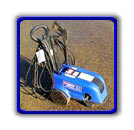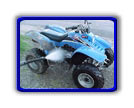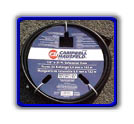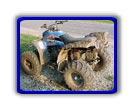Campbell Hausfeld Pressure Washer
| Product Evaluation Campbell Hausfeld Electric Pressure Washer |
 |
 With all the ATV’s we test, the job of keeping them clean was getting a little beyond a bucket of soapy water and a garden hose. Since this is an Internet publication, we looked to the Internet for a solution. We stumbled upon the C-H (Campbell Hausfeld) Power Store on-line and found out they sell merchandise that has been returned from retail stores. Since we were looking at pressure washers we checked out all their models. The prices were great compared to a retail store. Just to be sure, we went to our local K-Mart and checked out the Campbell Hausfeld 1750 psi electric pressure washer. Their price was 9.95. The same unit at the C-H Power Store was 5! Even with shipping we were still way ahead. Plus all C-H units come with a 1 year “Refurbished” warranty.
With all the ATV’s we test, the job of keeping them clean was getting a little beyond a bucket of soapy water and a garden hose. Since this is an Internet publication, we looked to the Internet for a solution. We stumbled upon the C-H (Campbell Hausfeld) Power Store on-line and found out they sell merchandise that has been returned from retail stores. Since we were looking at pressure washers we checked out all their models. The prices were great compared to a retail store. Just to be sure, we went to our local K-Mart and checked out the Campbell Hausfeld 1750 psi electric pressure washer. Their price was 9.95. The same unit at the C-H Power Store was 5! Even with shipping we were still way ahead. Plus all C-H units come with a 1 year “Refurbished” warranty. -Effective cleaning with rotary turbo nozzle
-1.9GPM
-19′ high-pressure hose with 2-piece gun and lance
-Built-in 1.2 gallon detergent tank
-35′ electrical cord
-Heavy-duty 115 volt, 15 amp induction motor
–1-Year Warranty
So, click, click! And it was ordered.
When the unit arrived we were amazed to see a pressure washe r that looked like it had never been used. Assembly was straight forward taking less than 1/2 hour. (Assembly note: Apply spray lube to the high pressure hose fitting to ease in disassembly. More on this later)
r that looked like it had never been used. Assembly was straight forward taking less than 1/2 hour. (Assembly note: Apply spray lube to the high pressure hose fitting to ease in disassembly. More on this later)
 a “Turbo” wand and develops a claimed 1750 psi. Basically this wand has a water powered spinning disc that rotates the water as it emerges from the wand.
a “Turbo” wand and develops a claimed 1750 psi. Basically this wand has a water powered spinning disc that rotates the water as it emerges from the wand.  lock it into position. With the water turned on, we laid out the gun and hose because it is recommended to not run the pump for any length of time without use of the gun to relieve the pressure. The switch was flipped and we had pressure! The adjustable wand could be set from a fine wide angle spray to a very powerful spot spray, capable of removing the toughest dirt (and factory applied decals if you’re not careful!) by simply twisting the knurled wand end. We settled on a spray adjustment of approximately 1/4 back from full narrow as a good compromise setting.
lock it into position. With the water turned on, we laid out the gun and hose because it is recommended to not run the pump for any length of time without use of the gun to relieve the pressure. The switch was flipped and we had pressure! The adjustable wand could be set from a fine wide angle spray to a very powerful spot spray, capable of removing the toughest dirt (and factory applied decals if you’re not careful!) by simply twisting the knurled wand end. We settled on a spray adjustment of approximately 1/4 back from full narrow as a good compromise setting.
Note: If you get inconsistent pressure immediately after starting up, it may be because of an air block in the pump (cavitation). We discovered that by removing the nozzle from the spray wand and activating the trigger, we were able to evacuate a large quantity of water and with it the trapped air. Then the pump stopped surging and the high pressure returned.
We next tried the “Turbo” wand. We found the spinning disc to be of little value and it sometimes stuck and refused to spin leaving us with water emitting at an angle. So we decided to circular file this “Turbo” wand and stick with the adjustable wand.
Next we noticed the 12 foot factory supplied high pressure hose (Note: Now a 19ft. OEM hose is supplied) just wasn’t long enough. We went to K-Mart and purchased a Campbell Hausfeld 25ft. accessory extension hose. Instead of connecting the two hoses together, we decided to test just the 25ft. length and we have been satisfied with this set up, feeling that with both hoses connected together, it would make coiling and rolling the unit around more difficult.
(Note: Now a 19ft. OEM hose is supplied) just wasn’t long enough. We went to K-Mart and purchased a Campbell Hausfeld 25ft. accessory extension hose. Instead of connecting the two hoses together, we decided to test just the 25ft. length and we have been satisfied with this set up, feeling that with both hoses connected together, it would make coiling and rolling the unit around more difficult.
 Falls Poker Run we were able to clean the very sticky caked-on clay off the Lakota Sport in just 15 minutes, start-to-finish, using nothing but cold well water. In some places the mud was 2in. thick! The amount of effort and time saved cleaning the Lakota’s undercarriage of sticky clay justifies the purchase price after just a couple of uses!
Falls Poker Run we were able to clean the very sticky caked-on clay off the Lakota Sport in just 15 minutes, start-to-finish, using nothing but cold well water. In some places the mud was 2in. thick! The amount of effort and time saved cleaning the Lakota’s undercarriage of sticky clay justifies the purchase price after just a couple of uses!

This is why you need to lube the aluminum threads because they
 will gall without lube. Blowing the water out prevents freezing water from damaging the pump’s internal components. Next activate the spray guns trigger while you coil up the high pressure hose to evacuate any remaining water.
will gall without lube. Blowing the water out prevents freezing water from damaging the pump’s internal components. Next activate the spray guns trigger while you coil up the high pressure hose to evacuate any remaining water.
During transport or use, be especially careful of dirt entering the water inlet, gun outlet or spray wand inlet. Doing so will cause the pump to shut down due to an over-pressure condition when the dirt plugs the outlet. When this happens, spray pressure falls to almost zero. Sometimes this condition can be remedied by using the included wire tool to poke the dirt particle out of the spray wand nozzle. However we found it sometimes can be blown right back into the nozzle again! So it is best to never get any dirt into the machine in the first place!
1. We found that 1300psi is more than adequate for the washing of an ATV.
2. We can’t imagine being in a location where we would have access to water under pressure and not have access to electricity.
3. It’s just another gas engine to service and lay-up during the winter.
